Key Insights 📈 📊
- Mastering narrative intelligence is a competitive imperative. Narrative intelligence unlocks immense strategic value for brands. Analyzing data to craft more resonant stories and optimize messaging gives brands an edge amid intensifying competition for audience attention.
- Listening is the foundation of a brand narrative. Listening to and understanding consumer narratives provides a roadmap for impactful brand storytelling. Monitoring tools reveal motivations, values, pain points, and desires that can shape brand messaging.
- Managing reputations is empowered by narrative intelligence. Narrative intelligence strengthens reputation management through early risk identification and rapid response capabilities. Tracking performance metrics spots emerging threats and guides data-driven mitigation.
- Influencer partnerships require narrative guidance. Identifying priority influencers through data-driven analysis optimizes collaborations. Narrative metrics ensure messaging resonates with creator audiences to maximize reach.
- Agility comes from narrative optimization. Ongoing optimization based on narrative analytics keeps brands agile and responsive. Continuously monitoring and adjusting stories provides an advantage as trends and sentiment evolve.
Storytelling is a powerful tool in marketing and public relations. Crafting compelling narratives that resonate with target audiences can boost engagement and drive desired actions. However, in today’s complex media landscape, simply telling stories is not enough. Brands must have a keen understanding of the broader narrative environment and how to position themselves within it strategically.
This ability is known as narrative intelligence.
Definition and Importance of Narrative Intelligence
Narrative intelligence is the capacity to craft, analyze, and optimize narratives to achieve business and communications objectives. It strategically uses storytelling and messaging to shape perception and influence beliefs. With strong narrative intelligence, brands can examine narratives from multiple perspectives, understand audience values and motivations, and develop authentic positioning within broader cultural narratives.
The benefits of narrative intelligence are clear.
It provides deeper audience insight, as analyzing macro and consumer narratives reveals motivations and values for more resonant messaging. Narrative intelligence enables effective positioning by identifying key narratives and properly situating the brand within them to build credibility and relevance. Examining the narrative environment also promotes an informed strategy for campaign development, storytelling, and engagement. Crafting an authentic overarching narrative ensures consistency across channels and touchpoints. Additionally, creating unique, distinctive narratives separates the brand from competitors.
Elements of Narrative Intelligence
Narrative intelligence comprises several key components. Listening to earned, owned, and social conversations provides insight into consumer and larger cultural narratives. Breaking down narratives through analysis surfaces patterns, arcs, symbols, characters, and other elements, revealing deeper meaning and values. This analysis determines where brand narratives intersect with cultural narratives, guiding strategic storytelling and positioning. Narrative intelligence also involves crafting narratives that authentically tap into consumer motivations resonantly. Finally, continuous performance monitoring and narrative optimization increase resonance over time.
Developing Narrative Intelligence
Building strong narrative insights takes concerted effort. Conducting narrative audits analyzes brand, consumer, competitor, and cultural narratives. Mapping core story elements and strategic narratives establish a framework. Developing listening capabilities identifies meaningful narratives. Creating frameworks to deconstruct narratives aids analysis. Testing narratives and storytelling through market research refine approaches. Continuously optimizing narratives based on feedback and outcomes sharpens strategies over time.
Narrative intelligence develops through experience. But brands that master strategic storytelling and narrative positioning stand to gain lasting competitive advantage.
The Multidisciplinary Nature of Narrative Intelligence
Narrative intelligence is a multidisciplinary domain, intertwining fields like cognitive science, psychology, linguistics, and anthropology. This multifaceted nature enriches its capability to dissect and construct narratives, providing a holistic approach to brand storytelling and analysis. Drawing from diverse disciplines gives narrative intelligence and a more rounded comprehension of what makes stories compelling and impactful.
Linguistics reveals how language and structure shape narratives. Psychology provides insight into cognitive processing and motivation. Anthropology situates narratives within cultural contexts. Together, these domains supply narrative intelligence with an intricate understanding of narrative construction and resonance.
This multidisciplinary perspective is key to fully grasping narratives and strategically applying storytelling. Brands that tap into the knowledge of diverse fields will wield narrative intelligence more effectively.
Core Functions of Brand Narrative Strategies
Narrative intelligence relies on several fundamental components working in unison.
| Function | Description |
|---|---|
| Listening | The evolution from conventional media monitoring to modern narrative analysis platforms marks a significant advancement, offering a more in-depth understanding of brand narratives and their impact. |
| Understanding | Processing and atomizing narrative data from various sources is pivotal for better comprehension of narrative trends and their implications on brand perception and engagement. |
| Data Analysis | The aggregation and analysis of narrative data provide actionable insights. Modern narrative intelligence platforms facilitate more nuanced analysis, enabling brands to discern narrative trends and adjust narrative strategies accordingly. |
Strategic Listening
Listening is a critical first step in developing a narrative strategy. It involves monitoring brand narratives across earned, owned, and social conversations. Sadly, traditional media monitoring tools do not have this capability, and it’s unclear if it’s even on their roadmap.
More advanced platforms analyze narratives across massive datasets using AI and machine learning. This enables more sophisticated listening techniques to surface meaningful narratives as they emerge. This automated approach surfaces meaningful conversational themes, sentiment patterns, and trending stories in owned, earned, and social media. Dashboards let brands filter volumes of data to focus on relevant strategic narratives.
Continuous listening informs narrative strategies and messaging in agile ways. Brands relying on outdated monitoring tools or manual analysis will struggle to keep pace with market narratives. But those leveraging advanced narrative intelligence platforms gain a competitive advantage.
Understanding the Context
Listening provides crucial insights, but making sense of the narrative data is equally vital. Processing and analyzing conversations from countless sources enables deeper comprehension of strategic narratives.
Advanced natural language processing can identify semantic relationships between words and concepts within brand, competitor, and cultural narratives. This automated analysis uncovers key themes, metaphors, symbols, and archetypes that resonate across core audiences.
Linking narrative performance data to business metrics provides further clarity. Brands can see how narrative engagement impacts funnel conversion rates, website traffic, sales, and other KPIs. This interconnectivity delivers actionable intelligence.
Also, comprehending the broad narrative environment reveals strategic opportunities to leverage or counteract specific narratives. Brands can tap into rising meme narratives that align with core messaging or reposition against regressing narratives that no longer resonate.
Deep Analysis
Listening and understanding can provide crucial narrative data. But, activating those insights requires in-depth analysis. The leading platforms enable nuanced examination of brand, competitor, and cultural narratives. This reveals performance patterns and trajectories to optimize narrative strategies accordingly.
These platforms can analyze volume, reach, resonance, share of voice, and sentiment for each narrative. Comparing this performance against benchmarks and business KPIs shows where to shift investments. Advanced multivariate analysis can highlight predictive correlations between narratives and metrics like website conversions.
Granular drill-down filters segment narratives by location, demographics, psychographics, audiences, etc. This precise analysis provides tailored insights to refine messaging and creative approaches for targeted groups. Brands can discern which narratives uniquely resonate among key audience segments.
At the end of the day, analytics can transform overwhelming narrative data into a clear strategic direction. The narrative intelligence unlocked guides brands to fine-tune stories, engage priority influencers, and tailor campaigns for maximum impact. Ongoing analysis continually optimizes narrative performance over time.
The Role of Storytelling in Narrative Intelligence
Storytelling is the heart of narrative intelligence. How brands craft and share their stories is critical for resonating with audiences. Yet storytelling alone is not enough. Truly effective narrative intelligence facilitates a two-way dialogue because the stories are more relatable and relevant.
Interactive Narrative Engagement
In the past, storytelling was largely one-way. Brands constructed narratives and pushed them out through advertising and owned channels. But today’s consumers and buyers expect more. They want to participate in narratives, not just passively receive them.
This journey from one-way to participatory storytelling underscores the importance of narrative intelligence. Rather than controlling narratives, brands must invite audiences into the storytelling process. They should foster meaningful conversations and experiences that immerse audiences in participatory narratives.
Crafting Compelling Stories
Of course, content and narrative quality remain crucial. Brands must craft compelling, authentic stories rooted in their purpose and values. Narratives should tap into consumer motivations and speak to their identity. Stories should develop across channels, weaving an engaging arc with symbolic meaning.
Strong writing and creative storytelling skills enable brands to shape powerful narratives. A multichannel perspective ensures alignment across touchpoints. Understanding the culture and psychology of target audiences informs impactful narratives.
A narrative analysis should be the north star of all brand messaging, from large campaigns to an editorial calendar.
Understanding Brand Archetypes
Narrative intelligence provides crucial insights to guide the development of impactful brand archetypes. By analyzing consumer narratives and cultural trends, brands can identify archetypes that resonate deeply with target audiences and the current zeitgeist.
For example, social listening may reveal rising disenchantment among youth segments toward traditional symbols of success. A Rebel archetype that rejects materialism and embraces activism could align well with this climate. Alternatively, the analysis may show high anxiety stemming from economic instability.
On the flip side, a Hero archetype providing security could strongly appeal. Data-driven models show which symbolic characters will connect with the audience’s feelings and desires.
Optimizing archetypes based on an ongoing narrative analysis enables brands to remain culturally relevant. As new trends and consumer sentiments emerge, narrative intelligence guides evolving archetypes and positioning to stay aligned. Brands that fail to recognize shifts through narrative analytics will cling to outdated and ineffective archetypes that don’t align with their business.
Facilitating Interactive Engagement
While crafting compelling narratives is crucial, narrative intelligence also requires facilitating interactive engagement. Brands should actively empower consumers to become co-creators rather than passive messaging recipients.
Strategies like co-creation campaigns, user-generated content, and immersive experiential activations provide conduits for two-way engagement. Of course, this means relinquishing control – consumers become partners in shaping brand narratives.
When done effectively, these interactive experiences can strengthen community affiliation and trust. By participating, audiences feel their voices are valued. This builds lasting connections as consumers integrate brands into their identity narratives. Also, interactive engagement provides invaluable first-party data to refine future messaging and experiences. Brands gain real-time feedback on what narratives resonate most with target demographics. New narratives can be tested and optimized based on engagement metrics and responses.
Technology Platforms Driving Narrative Intelligence
Recent years have brought major technological leaps in narrative intelligence. Advanced natural language processing, machine learning, and AI empower brands and agencies to derive strategic insights from vast unstructured data. Here are a few platforms that are leading the way.
| Platform | Description |
|---|---|
| Talkwalker Conversation Clusters | Interactive data visualization tool that analyzes social media, news, and consumer data to surface key narratives, relationships, and trends. Enables exploration of narrative clusters. |
| Nebula Social | Leverages AI to analyze social content and map narratives to influencer networks. Identifies rising narratives and influencers to optimize messaging. |
| Graphext | Interactive analytics platform for visual data exploration. Facilitates text analysis for narrative insights. Allows developing ML models to inform messaging. |
| Blackbird AI | AI platform identifying risky narratives across the web and social media. Measures disinformation campaigns. Helps mitigate reputation threats. |
| Infegy Narratives | Uses NLP and ML to uncover brand narratives and themes from social and news content. Enables data-driven messaging. |
| Nodus Labs (InfraNodus) | Visualizes text as network graphs to reveal relationships and narrative gaps. Generates strategic prompts to fuel AI systems. |
Talkwalker’s Conversation Clusters
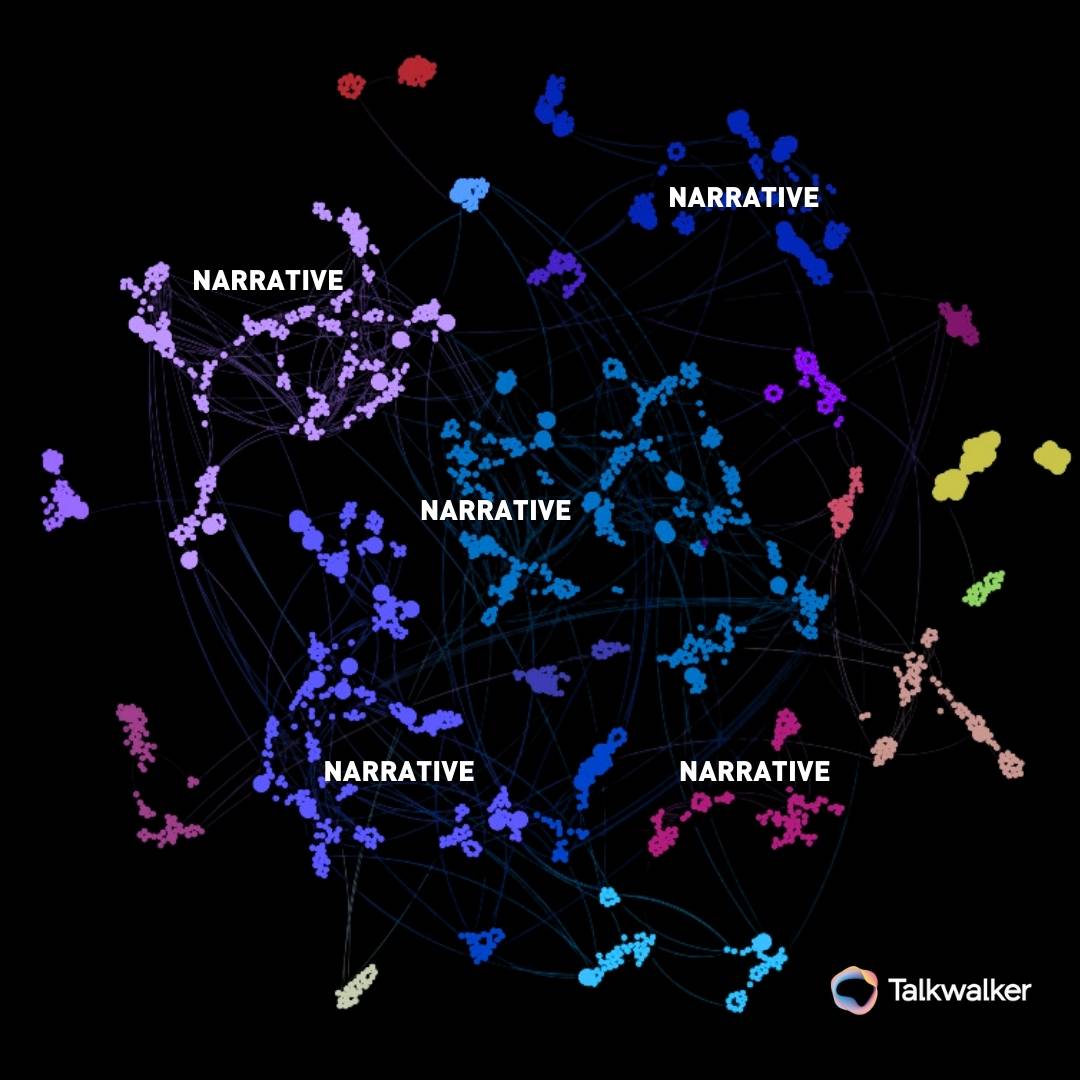
Talkwalker’s Conversation Clusters offers an interactive data visualization tool that delivers strategic narrative insights for brands. It leverages machine learning to rapidly analyze millions of social media, news, and consumer data points. Conversation Clusters reveals key narratives, relationships, and trends that inform messaging and engagement.
The technology groups semantically similar content into visual clusters representing dominant themes and topics. The size of each cluster conveys a volume of discussion, while connections between clusters reveal narrative relationships. The interface enables deep exploration of clusters to uncover granular metrics and consumer insights. Users can dive into specific narratives for details on engagement, drivers, and opportunities.
For brands seeking more informed narrative strategies, Conversation Clusters provides valuable intelligence. It swiftly surfaces shifts in opinion, debate dynamics, and emerging themes. Analyzing cluster connections identifies potential messaging angles and delivers strategic narrative insights at scale for brands aiming to optimize storytelling.
Nebula Social
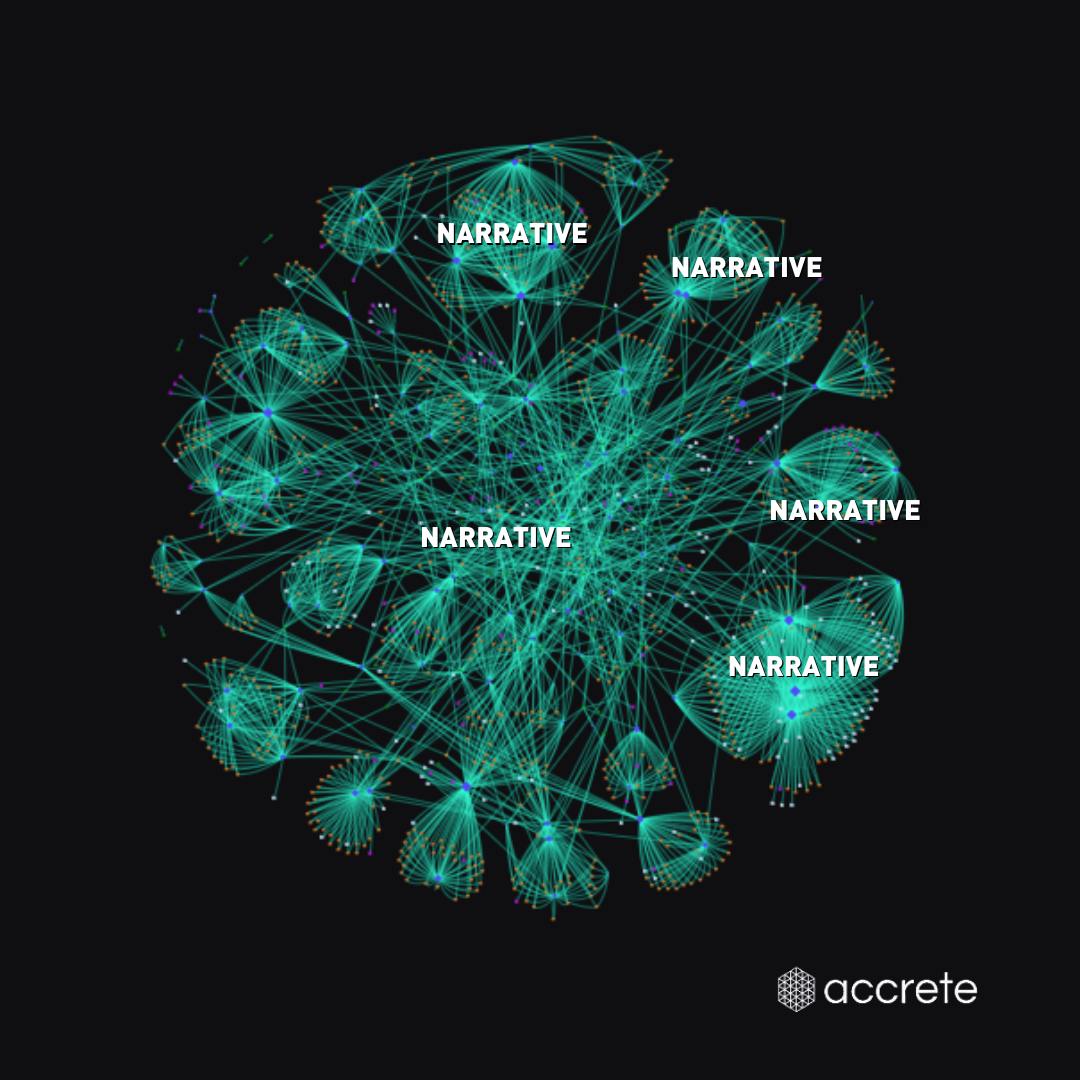
Accrete AI’s Nebula Social leverages advanced AI to uncover strategic narrative insights from social media data. As part of Accrete’s Nebula platform, Nebula Social analyzes massive amounts of social content using natural language processing.
At its core, Nebula Social builds knowledge graphs centered around influential accounts and emerging viral narratives. But it goes further by overlaying these graphs onto narrative clusters. This unique approach maps narratives to the key influencers driving them.
By identifying high-potential narratives and connecting influencers early, brands can get ahead of trends with optimized messaging. Influencer or “network” mapping provides crucial intelligence to guide partnerships, engagement, and narrative mitigation strategies. Nebula Social empowers insight into resonant narratives, the conversations shaping them, and the drivers of each.
Graphext
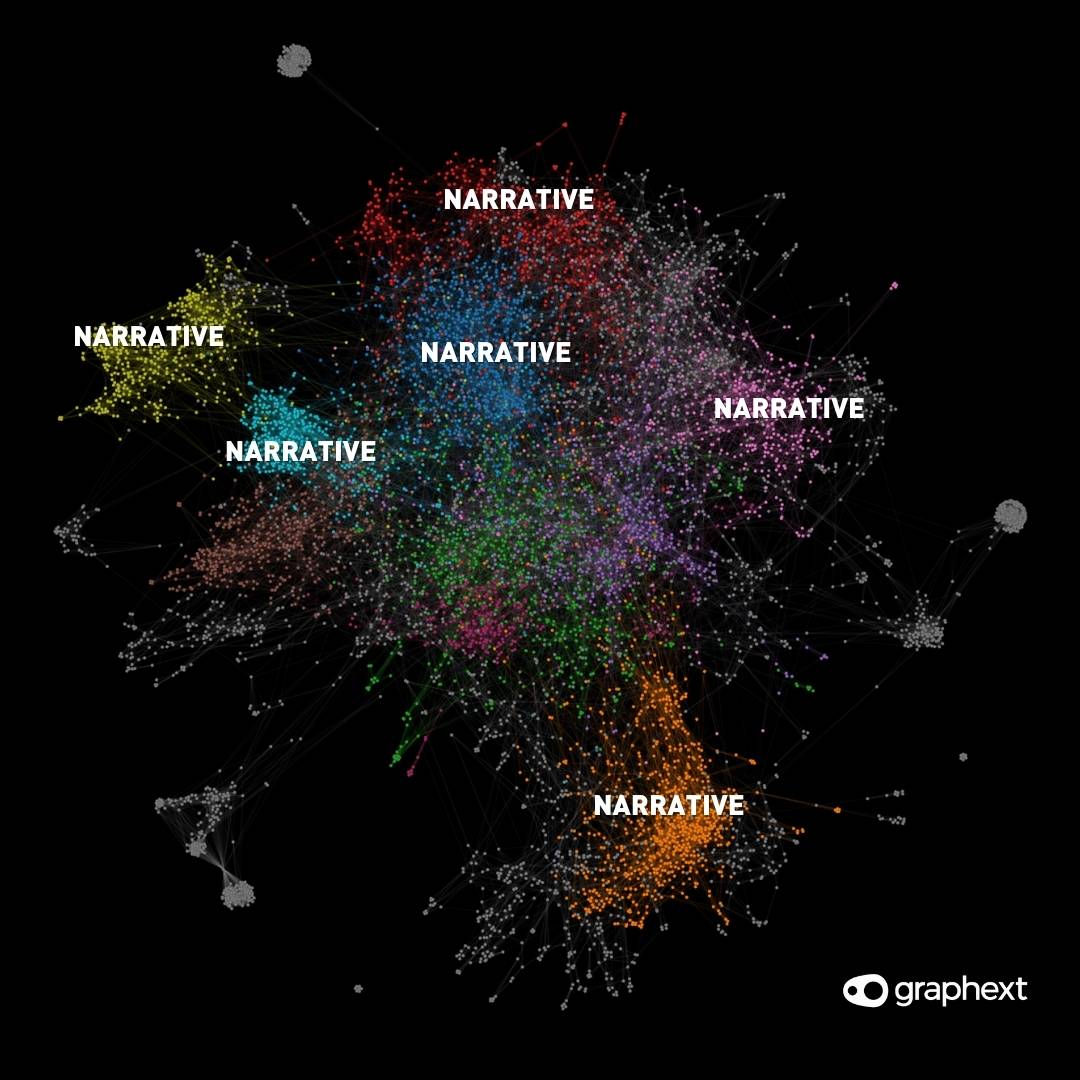
Graphext is a data analytics platform that uncovers hidden narratives and insights from any dataset–social media conversations, news data, reviews, etc. At its core, Graphext enables intuitive exploration of data distributions, relationships, and patterns through interactive visualizations. Exploratory analysis of custom data reveals crucial insights specific to the business. Users can visualize uploaded data to uncover hidden trends and opportunities.
The technology behind Graphext powers sophisticated text analysis using natural language processing that drives sentiment analysis, topic modeling, and keyword extraction of unstructured data.
Additionally, Graphext allows the development of machine learning models through a no-code interface based on the uploaded data. Resulting insights inform strategic messaging, positioning, and narrative pivots.
Blackbird AI
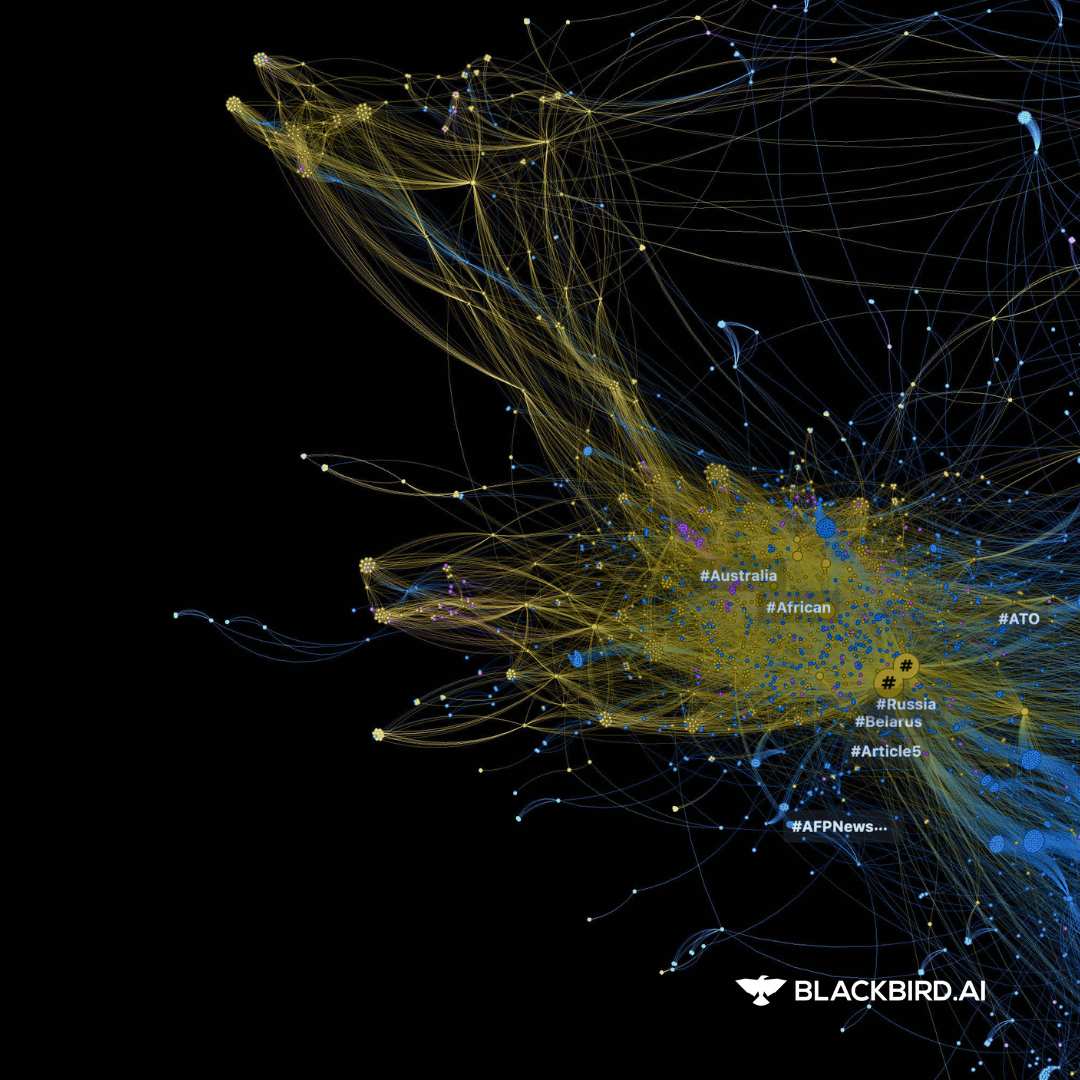
Blackbird AI offers an AI-driven narrative intelligence platform that enables brands to identify and respond to risky narratives that can harm reputations and finances.
With advanced narrative analysis capabilities, the Blackbird platform can optimize messaging and mitigate potential threats brewing in the marketplace. It provides real-time insights into emerging narratives, tracking the risk and propensity the stories will spread. Blackbird’s AI assesses content for toxicity, polarization, and inauthentic amplification, scoring associated dangers.
Their Constellation dashboard centralizes access to these narrative intelligence insights. It reveals ongoing disinformation campaigns and measures the success of response efforts through key risk metrics. Brands can clearly understand narrative threats and strategically address them.
Infegy’s Narratives
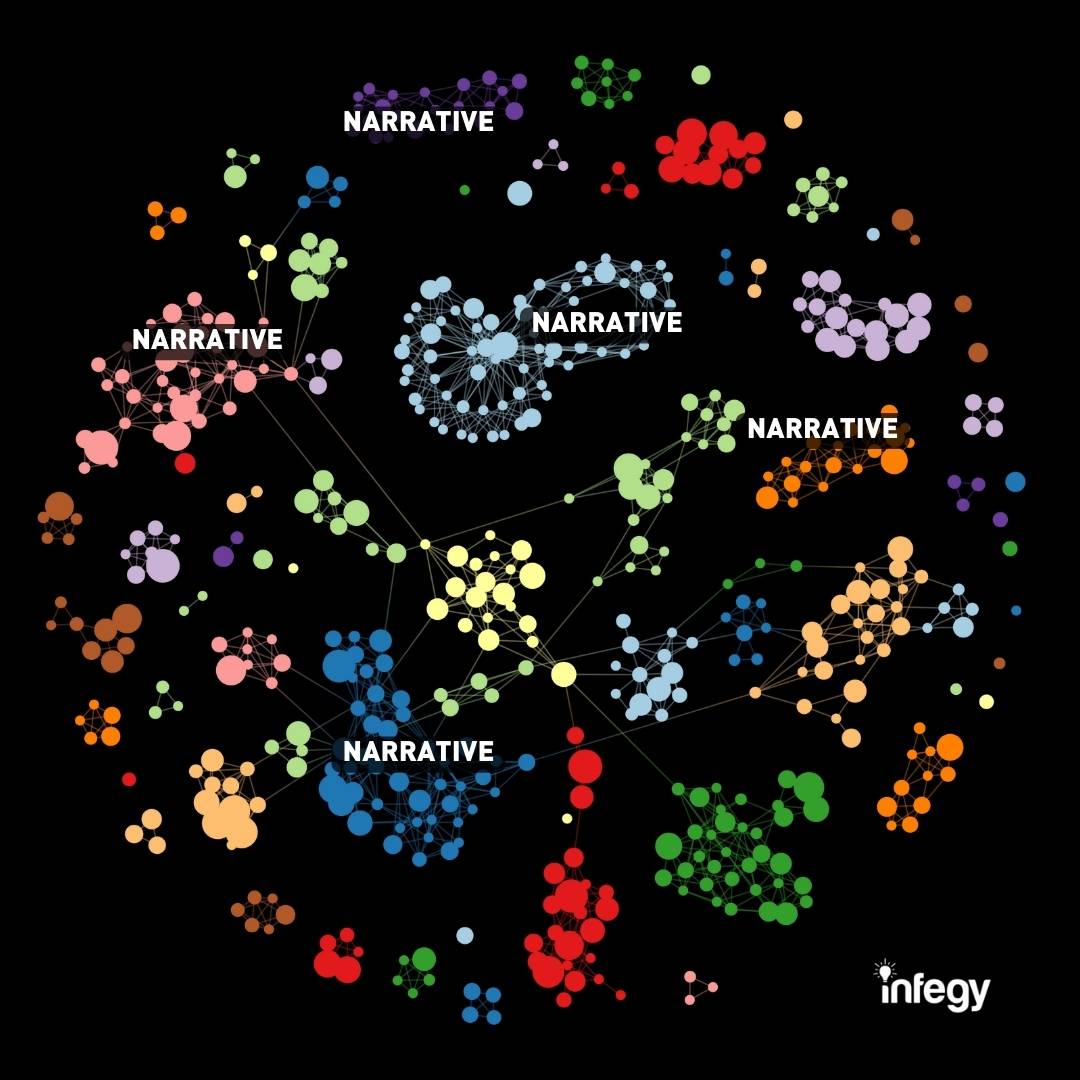
Infegy’s Narratives utilizes natural language processing and machine learning to uncover strategic narrative intelligence. The platform can identify relevant brand narratives and influential themes by analyzing large social media and news data sets.
Narratives can rapidly process millions of documents to categorize and cluster them into narrative topics. These insights are presented visually in an interactive graph that surfaces relationships. As new data streams, the narratives update dynamically to reveal real-time trends.
For each narrative, brands can analyze associated sentiment, demographics, influencers, and changes. This 360-degree view fuels data-driven messaging and narrative strategies.
Nodus Labs
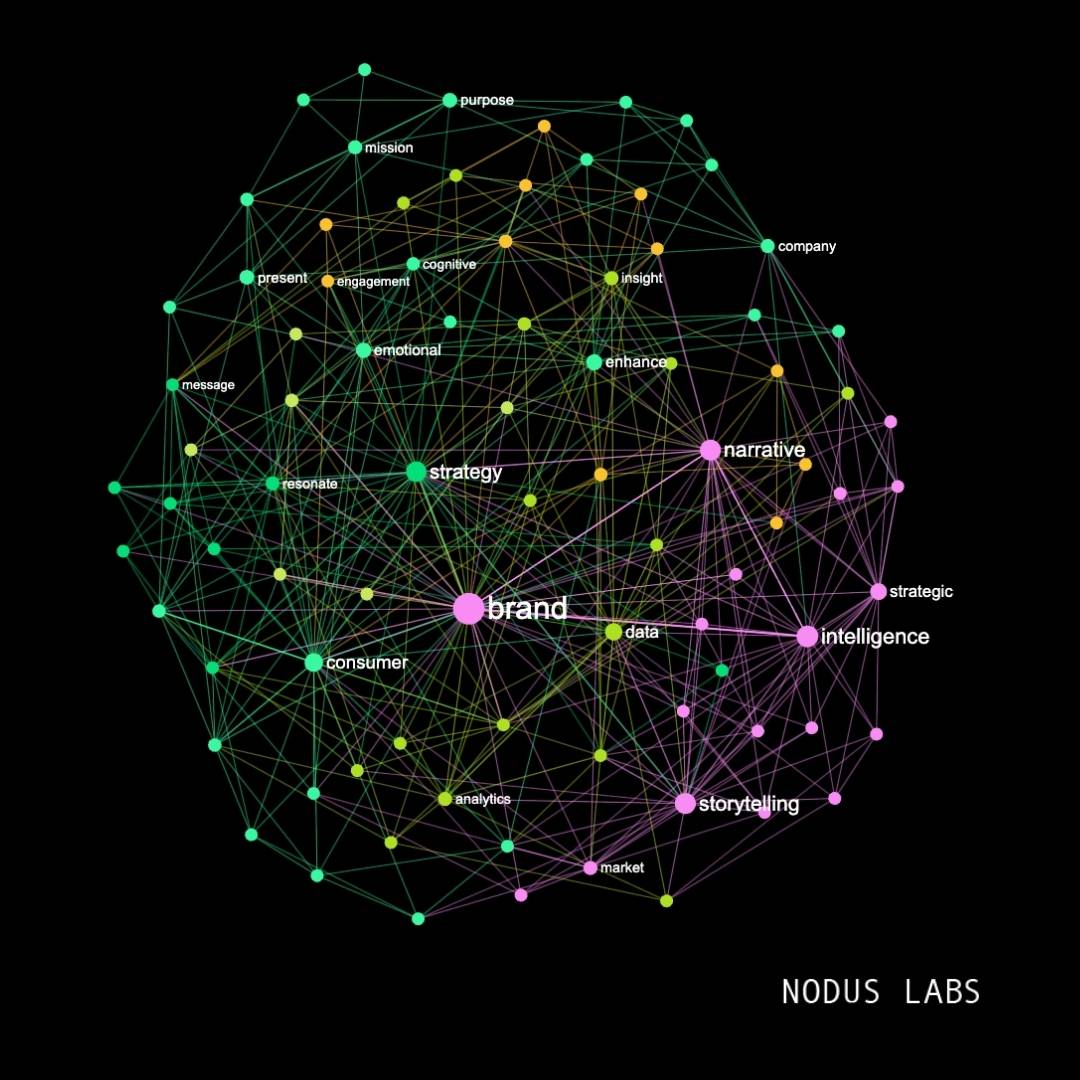
Nodus Labls (InfraNodus) is an AI-powered text analysis platform providing strategic narrative insights. InfraNodus uses network analysis and interactive visualizations to reveal hidden patterns, relationships, and gaps within any text or discourse.
InfraNodus visualizes text as a network graph, with words represented as nodes and connections based on co-occurrence. Advanced algorithms derived from network science analyze these text networks, surfacing influential concepts and clusters. Interactive exploration allows for zooming into parts of the graph, removing obvious terms to uncover peripheral ideas. Structural gaps between clusters illuminate potential narrative “blind spots” to address.
InfraNodus also generates strategic prompts using its network insights to fuel AI systems like GPT-3. The outputs provide additional perspective into narratives.
Applications of Narrative Intelligence in Brand Management
Narrative intelligence has become an invaluable tool for modern brand management. When applied, it can help brands across several key areas:
| Application | Description |
|---|---|
| Identifying Narrative Threats | Narrative intelligence helps identify emerging risky narratives like disinformation or malicious rhetoric. Monitoring tools analyze content across the web to flag manipulative stories so brands can counter them. |
| Crafting Relevant Narratives | Analyzing macro and consumer narratives provides insights into motivations, values and identity. Brands can develop more resonant, consistent messaging across touchpoints. |
| Reputation& Risk Management | Monitoring narrative performance metrics allows agile responses to crises by tracking volume, reach, sentiment, etc. Narrative intelligence strengthens reputation management. |
| Customer & Stakeholder Engagement | Interacting directly with priority audiences creates positive narratives. Narrative intelligence guides authentic engagement through co-creation, UGC and immersive experiences. |
| Influencer & Creator Marketing | Narrative analysis identifies key creators and audience values to guide partnerships. Aligning with cultural narratives through influencers expands reach. |
| Competitive Intelligence & Positioning | Monitoring competitors and identifying narrative gaps enables crafting unique brand stories and cementing thought leadership. |
Identifying Narrative Threats
In today’s hyperpolarized climate, brands face constant threats from weaponized narratives spreading online. Coordinated disinformation campaigns, rhetoric from both sides and malicious propaganda can quickly spiral out of control on social platforms. These dangerous narratives can severely damage brand reputations and finances if left unchecked.
This is where narrative intelligence provides vital defensive capabilities. Sophisticated AI-driven monitoring tools continuously analyze content across the social web to identify emerging risks early. Most platforms mentioned use natural language processing to assess rhetoric and coordination patterns that signal building threats. These tools can detect risky narratives while still percolating in fringe networks before reaching mainstream platforms.
Armed with intelligence into nascent threats, brands can deploy proactive countermeasures to intercept and disarm them. They may work with influencers and partners to disseminate facts drowning out false claims. Create owned content optimized with the right keywords that set the record straight. Tailored social ad campaigns can promote brand values and shape discourse toward more constructive dialogues. Or directly engage concerned communities to address misinformation. Quick action helps mitigate damages as adversarial narratives spread.
Essentially, narrative intelligence moves brand defense from reactive crisis response to proactive resilience. Ongoing monitoring, analysis, and preemptive engagement empower brands to dismantle threats systematically before detonating. Competitors without such capabilities will remain vulnerable to strikes from weaponized narratives.
Craft More Relevant Narratives
Today’s media landscape demands more from brand storytelling. Simply crafting narratives is inadequate when audiences are overwhelmed with choices. Brands must tap into narrative intelligence to develop messaging that truly resonates. The key is analyzing macro and consumer data to uncover insights about audience motivations and values.
Sophisticated listening tools track consumer narratives circulating across social platforms, community forums, and owned channels. Advanced AI reveals the underlying desires, pain points, and worldviews that different demographics relate to. These behavioral insights guide narratives tailored to what diverse consumers care about most.
With this intelligence, brands can weave narratives that tap into rising cultural trends. Campaign creative can incorporate visual and verbal symbols proven to generate engagement among target groups. Messaging can be adjusted for different platforms while retaining the core brand voice.
When informed by data-driven narrative insights, brand storytelling becomes as precise and effective as personalized direct mail. It evolves beyond guesswork into an intelligent dialogue with consumers. Narrative intelligence is now essential for brands striving to break through the noise.
Reputation & Risk Management
Today’s volatile media landscape demands brands proactively manage their reputations and avoid “being canceled.” Narrative intelligence is proving vital for identifying emerging threats and opportunities early. Instead of reacting to issues, advanced analytics provide the intelligence needed to recalibrate narratives preemptively.
Powerful dashboards track narrative performance metrics across demographics and regions in real time. Sudden spikes or drops in reach, sentiment, and resonance reveal risks and chances to reframe narratives. Past reputation crises provide perspective on patterns.
Equipped with narrative insights, analysts can advise rapid response to counter reputation threats and stem viral crises before they erupt. This may involve contextual messaging, strategic influencer partnerships, or launching tailored counter-narratives to reshape discourse. Quick shifts in narrative strategy help mitigate damages.
Narrative analytics also highlight rising narratives where brands can proactively build awareness and goodwill as a buffer against cancellation. Sustaining relevance requires optimizing messaging for emerging stories with traction.
Customer & Stakeholder Engagement
While risky narratives threaten, strategic narratives present huge opportunities to strengthen stakeholder trust. Positive brand stories build affinity and trust into enduring relationships with customers.
Narrative intelligence is invaluable for determining which audience segments should become engagement priorities. Analyzing data reveals the demographics, psychographics, and influencers most receptive to tailored outreach and messaging. Ongoing narrative listening also uncovers emerging concerns brands can preemptively address.
Powerful narratives invite audiences into participatory storytelling experiences that organically deepen bonds. Campaigns featuring user-generated content and customer co-creation boost affinity by reflecting stakeholder voices. Retail spaces, brand events, and immersive activations designed around narrative insights resonate more with audience values.
Essentially, narrative intelligence enables evolving beyond impersonal broadcast messaging to meaningful engagement through analyzing narratives. The data-driven insights uncover where authentic connections will truly resonate and build community.
Influencer & Creator Marketing
Influencer and creator collaborations are growing more critical for brands seeking to shape narratives effectively. Yet strategically choosing the right voices and optimizing resonant messaging presents persistent challenges. This is where narrative intelligence lends much-needed clarity.
By thoroughly analyzing audience data and macro trends, brands can identify category leaders with strong resonance among their target demographics. Competitive analysis reveals untapped creators operating within whitespace narrative spaces optimal for differentiation. Ongoing monitoring of rising cultural narratives guides partnerships timed to tap into trending stories.
Narrative intelligence also enables crafting authentic messaging that genuinely reflects creator voices rather than seeming forced. Analysts can pinpoint which motivations, values, and pain points an influencer’s followers relate to most. Tailored co-created narratives feel organic and honest.
Post-campaign analysis of engagement, sentiment, and conversions demonstrates tangible ROI, further refining future activations based on data-driven insights. Continual optimization allows brands to maximize impact over time through more strategic alignments.
For brands struggling to cut through noise, narrative intelligence brings much-needed clarity to influencer marketing. Data-informed matching and messaging ensure collaborations expand reach by plugging into resonant cultural narratives. As competition for creator attention intensifies, these data-driven insights will only grow more indispensable.
Competitive Intelligence & Positioning
Gaining an advantage in crowded modern markets requires crafting a unique, differentiated brand narrative. Yet, defining their strategic niche amidst deafening noise presents a struggle for many brands.
By analyzing competitors’ positioning across sectors, brands can accurately identify strategic gaps in the narrative landscape. These whitespace opportunities become prime areas to establish thought leadership through bold, compelling messaging grounded in human truths.
Ongoing monitoring reveals how competitors respond and pivot to capitalize on emerging trends, crises, and zeitgeist shifts. This intelligence guides adapting brand narratives with agility to create strategic contrast when situations allow.
Additionally, closely examining evolving cultural narratives surrounding social issues, new technologies, and entertainment phenomena reveals timely opportunities to weave brands into the cultural fabric through distinctive narratives finely attuned to consumer values. Linking brand purpose to cultural narratives cements relevance and resonance.
Narrative intelligence enables brands to continually reassess and optimize strategic positioning as the competitive and cultural landscape changes. It also delivers indispensable insights for organizations seeking to own whitespace narratives while dynamism remains differentiated in a shifting context.
Future of Brand Narrative Intelligence
As narrative intelligence matures, exploring predictive capabilities marks a key future direction. Advanced AI may one day forecast which narrative trends resonate most or pose reputational risks. This could enable brands to craft narratives for maximum effect preemptively.
Continued AI progress will likely drive many future advancements. Automated analysis of multimedia content, not just text, could reveal nuanced narrative insights. Sentiment detection and emotional intelligence may also improve understanding of audience values and how they may shift in real-time.
Overall, narrative intelligence aims to move beyond reactive listening into proactive strategy. Predictive analytics, enhanced multimedia analysis, and sophisticated AI will help unlock this future potential. Brands that leverage these emerging capabilities will gain an advantage.
Challenges and Limitations
While promising, narrative intelligence also poses challenges. Ethical considerations around aggregating data and manipulating narratives raise concerns. Without proper governance, narrative strategies may overly rely on psychological targeting.
Practical limitations also exist. Despite advanced AI, narrative analysis still requires human oversight and interpretation. And lack of quality data can skew automated insights.
There are also risks of over-optimization. Brands must balance narrative performance metrics with overarching purpose, authenticity, and brand voice. An obsessive focus on data can lose sight of relevant storytelling. A brand can never be everything to everyone.
Due to these concerns, a balanced approach is needed. Narrative intelligence should aim to inform human creativity and judgment, not replace them. A wise investment in smart governance, ethics training, and executive education will help overcome limitations.
With a thoughtful approach, brands can ethically apply narrative intelligence to build meaningful consumer connections through resonant storytelling. However, the technology must be carefully managed to avoid reputational and societal risks.
Final Thoughts
Storytelling is an immensely powerful brand tool to shape perception, influence beliefs, and drive engagement. Yet, crafting stories is not enough in today’s crowded media landscape. Brands must cultivate narrative intelligence – strategically analyzing, optimizing, and positioning narratives for resonance and impact.
As this article has explored, narrative intelligence confers many benefits for brand management. It provides a deeper understanding of motivations and values to craft more compelling messaging. Monitoring brand health through narrative KPIs strengthens reputation management. Analyzing influencers and cultural narratives guides effective partnerships and positioning. Facilitating interactive engagements builds affinity and community.
The narrative intelligence domain has rapidly matured with recent technological advances in AI, natural language processing, and data analytics. Powerful new platforms help uncover strategic insights at unprecedented scale and sophistication. This empowers brands to optimize narrative strategies based on data-driven intelligence.
Yet narrative intelligence is not without risks and limitations. Ethical considerations around data privacy, psychological targeting, and narrative manipulation necessitate responsible oversight and governance. Human creativity and wisdom must remain at the center to guide the use of these tools.
When applied judiciously, narrative intelligence helps brands craft more resonant stories, foster authentic engagement, and achieve measurable impact. Investing in ethical narrative intelligence will become imperative as consumer motivations and the narrative landscape grow more complex. Brands that harness their full potential while mitigating risks will gain enduring strategic advantage.
FAQ
Narrative intelligence is the strategic ability to craft, analyze, and optimize brand narratives using data-driven insights to achieve business objectives.
Narrative intelligence helps brands create more resonant, effective messaging. It provides a deeper understanding of motivations and values to guide storytelling.
The main components are listening, understanding, and analysis. Advanced platforms listen to conversations across channels, make sense of narrative data, and enable in-depth analysis.
Narrative intelligence reveals what narrative elements will resonate most by surfacing insights into audience desires, pain points, and values. This guides crafting compelling stories.
Ongoing monitoring of narrative performance metrics quickly identifies potential reputation threats. Rapid response informed by data mitigates risks.
Narrative intelligence identifies which audiences to prioritize and guides crafting narratives authentically resonating with their values. This drives engagement.
Analysis of audience data matches brands with influencers that expand reach. Narrative metrics ensure messaging effectiveness.
Likely future innovations include predictive analytics, enhanced multimedia analysis, and sophisticated emotion AI to provide even deeper narrative insights.
Ethical data use, preserving creativity, avoiding over-optimization, and maintaining authenticity are key challenges to address.
Good first steps are conducting a narrative audit, developing listening capabilities, and exploring leading narrative analytics platforms. Moving from a reactive to a proactive strategy is key.
